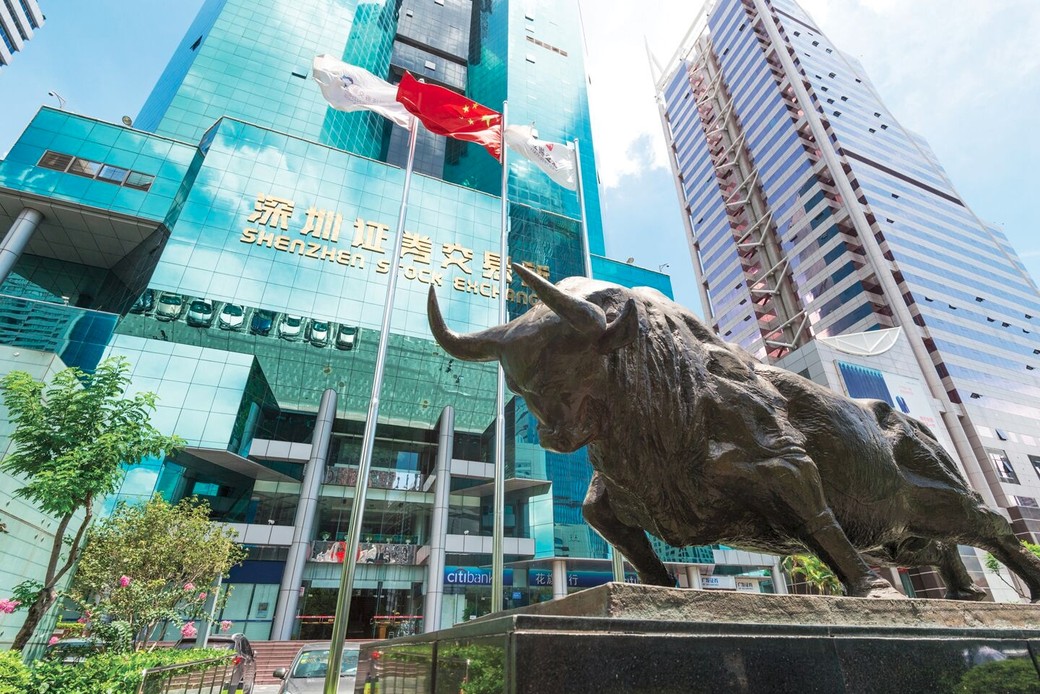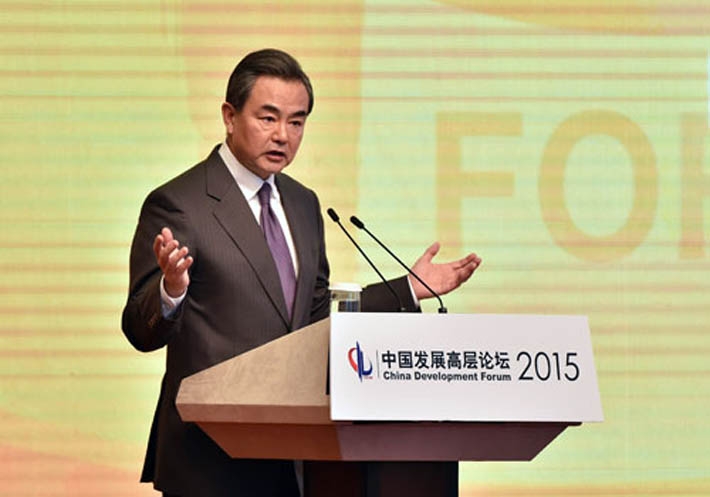
Sustained and Steady Growth of the Chinese
Economy will Continue to Make a Significant
Contribution to the Development of the World Economy
In the first half of this year, despite continued slowdown in global growth, China’s GDP expanded by 6.7 percent, ranking among top of the world’s major economies. This growth rate was within the appropriate range and met the projected target. It’s indeed not easy for an economy with a scale of more than 10 billion US dollars. To understand China’s economy, one should focus on the following aspects:
First, China’s economic performance has been basically stable. Last year, China’s economy grew at 6.9 percent. And this year the target is 6.5 percent,-7 percent. We have full confidence to achieve this goal. Major economic institutions from China and the world forecast that the Chinese economy will grow at an average annual rate of at least 6.5 percent over the next few years.
China needs to create ten million plus new urban jobs every year, and 7.17 million were created during the first half of this year. At the same time, people’s incomes increase steadily. In the first six month this year, CPI grew by 1.9 percent and per capita income of urban and rural residents rose 6.5 percent. People’s lives are guaranteed and improved. In a word, the aim of maintaining stable growth is primarily to ensure employment and promote the people’s well-being.
Second, China’s macro-economic policies have maintained continuity and stability. China will continue to innovate means of macro control, implement the proactive fiscal policy with greater intensity and efficiency, and carry out the prudent monetary policy in a flexible and appropriate fashion. The current debt ratio for the Chinese government is around 40 percent and is only around 16 percent for the central government, lower than many other major economies.
China’s deficit-to-GDP ratio is a mere 3 percent, which gives Chinese government space for a proactive fiscal policy. China’s household saving rate remains high. All this means huge potential for the development of multi-tiered capital markets and major leeway for improving financial regulation methods and financial resource allocation. The Chinese government has strong ability to prevent systemic or regional risks.
Third, positive progress has been made in reform, innovation, adjustment and transformation. And development potential has been further unleashed as a result of reform efforts to streamline administration, delegate powers, and improve the business system as well as fiscal and financial system. In the first half of the year, some 40,000 new market entities are being created every day in China, including over 13,000 new enterprises. Such increase is bigger than the previous two years. China’s economic structure continues to improve. In the first half of this year, the contribution of the service sector to economic growth reached 59.8 percent, with an increase of 4.2 percent compared to the same period of time of last year. The contribution of domestic demand to GDP increased to 110.4 percent with a year-on-year rise of 14.5 percent. The growth of the total retail sales of consumer goods reached a stable level of more than 10 percent. New areas of consumption such as information and communication, smart phones and new energy vehicles are rapidly expanding. The five “happiness industries” of tourism, culture, sports, health and old-age care are rapidly growing. The leading role of consumption and services is becoming more visible. An innovation-driven economy is brimming with vitality. High-tech industries, high-end manufacturing, e-commerce and other new business forms are booming. Enterprises, sectors and regions that have made an early start in economic transformation and upgrading and that embrace faster growth of new industries have all taken on a sound momentum of growth.
Fourth, China’s economy is resilient with huge potential untapped. China has a 900 million strong workforce, among whom 170 million have received higher education or training in professional skills. Every year we produce over seven million college graduates and over five million graduates from secondary vocational schools. We are No.1 in the world in terms of the number of science professionals and No.2 in R&D input, with an input of over RMB 1 trillion made last year. China is the second biggest economy, the largest manufacturing country, a major trading nation in goods and services, and a major destination and source of foreign investment. It is also the world’s second largest consumer market. Its middle-income population is in the hundreds of millions and is still expanding. The number of the rural poor is falling year by year, while that of permanent urban residents is growing by over 10 million each year. All these make China a major emerging market with the biggest growth potential. It makes China a big stage where people from every corner could tap into their intellectual potential and start their business. We are fully confident that the Chinese economy will embrace a bright prospect.
China’s sound economic development has been echoed by major international economic and financial institutions while downgrading its growth outlook of the world economy and many developed economies such as the United States and Japan, the International Monetary Foundation upgraded China’s economic growth outlook for this year by 0.1 percentage points, according to the IMF World Economic Outlook Updatereleased in July. On July 22, at the “1+6” round table dialogue between Chinese Premier Li Keqiang and the heads of six major international economic and financial institutions such as the World Bank, the IMF, the World Trade Organization, the International Labor Organization, the Organization for Economic Cooperation and Development as well as the Financial Stability Board, all parties said that the measures of the structural reform in China’s economy prove to be fruitful, with economic growth more resilient and more sustainable. The prophecy of “hard landing” of Chinese economy will no longer be bought.
In the meantime, we are also aware that the Chinese economy is confronted with some difficulties, problems, risks and challenges. Given the complex and challenging international environment and the deep-seated domestic problems accumulated over the years, the foundation underpinning stable performance of the Chinese economy is yet to be strengthened. The driving effect of external demand on growth is waning. Private and manufacturing investments are sluggish. Latent risks still exist in the financial and other sectors. In some industries with serious overcapacity and regions with monotonous economic structure, there have been relatively more problems. Downward economic pressure remains and the difficulties are not to be underestimated. These difficulties, problems, risks and challenges have occurred in the course of growth and progress. They are nothing but growing pains. We have full confidence and capability to stand up to challenges, overcome difficulties and solve these problems.
The Chinese economy is at a crucial stage of transition from old to new growth drivers and a stage of economic transformation and upgrading. For the economic development in the years ahead, the Chinese government has clear and well-developed strategies. We will focus on development as the top priority and promote steady progress as we pursue innovative, coordinated, green, open and shared development. We will ensure that the government’s macro policies are stable, industrial policies are well-targeted, micro policies are flexible, reform policies are solid and social policies meet people’s basic needs. In the face of mounting downward economic pressure, China will not resort to indiscriminate strong stimulus. Instead, we will focus on exploring new models of macro control, vigorously advance structural reform, and concentrate our efforts on cultivating new drivers of growth while upgrading traditional ones. While appropriately expanding aggregate demand, China will steadfastly advance supply-side structural reform, concentrate on cutting overcapacity, reducing inventory, deleveraging, lowering costs and strengthening weak links, so that China’s development could be less reliant on natural resources and be more driven by human resources and innovation. This will enable the Chinese economy to maintain medium-high growth rates and move to medium-high development levels.
In the upcoming period, China’s economic development will mainly focus on the following areas:
First, China needs to guide economic transformation and upgrading through innovation. Through further implementation of the innovation-driven development strategy, China will step up efforts to build an innovation-driven country and a strong country in science and technology, so as to provide robust support for economic transformation and upgrading. We will vigorously promote the commercialization of innovation results and facilitate the emergence of more new industries, new forms of business and new business model so as to accelerate the development of the new economy and cultivate new growth drivers.
Second, China needs to accelerate transforming and upgrading traditional industries. China needs to reduce inefficient and low-end supply, and expand effective and medium-to high-end supply through advancing structural reform, in particular that on the supply side. A major task for China is to phase out outdated production capacity and address overcapacity.
Initial progress has been made in recent years, as is shown in the lowering production of raw coal and crude steel. China will implement the Made in China 2025 initiative to make manufacturing more IT-based and smarter. China will conduct custom-tailored and flexible production to meet consumers’ diverse needs. We will accelerate changes in models of production, management and marketing and create new industry chains, supply chains and value chains. This will make Chinese manufacturing more competitive.
Third, China will advance the Mass Entrepreneurship and Innovation strategy. If we could make full use of the Internet to efficiently match the massive amounts of information about supply with that about demand, we could then unleash everyone’s potential, bring about cooperation among and sharing of R&D and professional expertise and skills, so that individual efforts of numerous market players will lead to greater synergy for innovation-driven development. The sharing economy is something that everyone can take part in and benefit from. It could also facilitate reasonable income distribution, expand the middle income group, allow more people, in particular the young, to fulfill their dreams through hard work, and promote social equity and justice.
Fourth, China needs to transform government functions more rapidly and improve efficiency. China needs to further streamline administration, delegate power, and improve services. At the same time, China also needs to strengthen and innovate in market oversight, strictly protect intellectual property rights, promote in a coordinated way reforms in the fiscal, taxation, finance, investment and other key areas, and ensure a level-playing field for all players and a pro-innovation institutional environment.
Fifth, China will further deepen reform and opening-up policy. China will enhance the open economy, open wider the service sector and general manufacturing sector, provide more investment opportunities to foreign businesses and foster a fairer, more transparent and predictable investment environment.
As a developing country, China will continuously make an important contribution to the world economy if it maintains steady economic growth. China’s economy will still be the “driver” and “anchor” of the global economy for the coming years. In 2015, China contributed roughly 30 percent to global economic growth. The World Bank forecasts that China’s contribution to the world economy will continue to significantly lead over other major economies for the next few years, with a contribution rate of 26.4 percent in 2018. In the next five years, China’s economy will continue to achieve medium-high growth rate. Its import is expected to reach US$10 trillion and its outbound direct investment will exceed US$600 billion.
China and Canada are the major players of G20, APEC and other important multilateral institutions, both countries shoulder the shared responsibilities to boost the steady recovery of the global economy. China and Canada have many similarities in development strategies and share strong complementarity in industrial structure, which promise huge potential for trade and economic cooperation.
China and Canada need to make joint efforts to realize the mutual supplement with each other’s advantages, keep deepening practical cooperation in various areas, strive to expand the volume and scale of bilateral trade and economic cooperation, launch the process of negotiating and signing FTA arrangement at an early date. The two countries should also continue to enlarge the cooperation in clean energy, financial services, innovation and technologies, infrastructure and other areas, so that we can jointly create a new “Golden Era” in our bilateral relations and make more positive contribution to the peace and development in the Asia-Pacific and the world as a whole.













